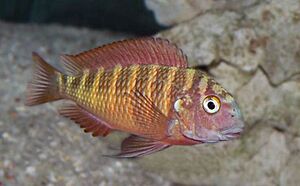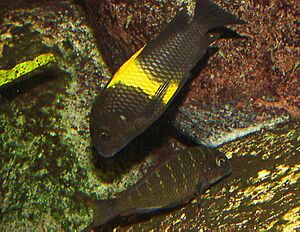Blunthead cichlid facts for kids
Quick facts for kids Blunthead cichlid |
|
|---|---|
 |
|
| Tropheus moorii "Chimba" | |
| Conservation status | |
| Scientific classification | |
| Synonyms | |
|
The Tropheus moorii, also known as the blunthead cichlid, is a type of cichlid fish. It lives only in Lake Tanganyika in Africa. These fish are famous for their many different colors, with over 40 kinds found throughout the lake. They can be dark green, bright red, or yellow! Blunthead cichlids mainly eat filamentous algae, which they find on rocks in shallow waters. Female blunthead cichlids are special because they are "mouthbrooders." This means they carry their eggs and young fish inside their mouths until they hatch and grow big enough to swim on their own.
Contents
Home and Habits
Both male and female adult blunthead cichlids have their own special feeding areas, called territories. Fish living in deeper water tend to be smaller but have larger territories. Males usually have bigger territories than females.
A female will leave her territory to find a male. She might visit several male territories many times before choosing one. Once a male and female pair up, the female will eat in his territory for up to three weeks. This happens before she lays her eggs. After laying her eggs, the female leaves the male's territory. She finds a small, empty spot to stay during the time she carries her young in her mouth. Males, on the other hand, usually stay in their territories for months, even if no females visit them.
Sharing Space with Other Fish
Blunthead cichlids often have territories next to other blunthead cichlids or even different kinds of fish. For example, a male blunthead cichlid will try to attract a female of his own kind to his feeding territory.
In Lake Tanganyika, blunthead cichlids live alongside other plant-eating cichlids. These include P. trewavasae, P. orthognathus, P. polyodon, and T. temporalis. Blunthead cichlids, P. polyodon, and T. temporalis usually get along with each other. But they can be aggressive towards other fish species and even other blunthead cichlids. Even though their territories often overlap, these three species usually don't bother each other. This is because they eat different things. For example, P. polyodon and P. trewavasae mostly eat tiny, single-celled algae, not the stringy algae that blunthead cichlids prefer.
Sometimes, having overlapping territories can be helpful. For example, when P. polyodon eats, it cleans silt off the rocks. This makes it easier for blunthead cichlids to scrape off their favorite stringy algae. Also, blunthead cichlids and P. trewavasae might team up to defend their territories from bigger fish like P. orthognathus. Together, they can chase away these larger fish, which a single blunthead cichlid might not be able to do alone.
Who's the Boss?
Blunthead cichlids often show who's in charge based on their size when defending their territory. If another fish enters a blunthead cichlid's territory, the owner might attack it or try to scare it away. They do this by spreading their fins and quivering their tails. These interactions usually happen near the edges of their territories. If a territory owner attacks, it will chase the intruder until it leaves.
How they interact depends on how big the territory owner is compared to the intruder. Fish tend to attack smaller fish. They usually try to scare away bigger fish with displays. Attacks can happen anywhere, but displays usually happen inside the territory. Displays are rare if there's a big size difference (more than 2.5 cm). They are more common if the size difference is small (less than 2 cm). If two fish are about the same size, they are very likely to attack each other.
Mating and Raising Young
Blunthead cichlids have a unique mating system called "serial monogamy." This means a male and female form a temporary pair to lay eggs. The female then carries the eggs and young in her mouth. The male doesn't help with raising the young, so he is free to find other females. All the eggs from one female are fertilized by a single male.
Females lay up to 20 bright orange eggs on a rock surface. The eggs stay in the mother's mouth for 30 to 35 days. When the young finally leave their mother's mouth, they are already well-developed. They are ready to live like adult fish.
Feeding Their Babies in Their Mouths
"Buccal feeding" is when a mother fish feeds her young while they are inside her mouth. Female blunthead cichlids put a lot of effort into raising their babies. They lay large eggs and also feed their young inside their mouths. Blunthead cichlids have very large eggs compared to their own body size.
In the beginning of the mouthbrooding period, the mother fish rarely eats. But after the eggs hatch, she starts eating again to feed her young. The mother basically "starves" herself during this time. All the food she eats goes to nourish her young. The yolk sacs of the eggs are used up around day 25 of mouthbrooding. But the young aren't released for several more days. So, during this time, all their food must come from the mother's buccal feeding.
Buccal feeding uses a lot of energy for the mother because it means she has to swim more. This feeding doesn't make the mouthbrooding period shorter. Instead, the young that are fed this way are bigger, heavier, and faster. These benefits are very helpful for the young fish. They lower their risk of being eaten by predators. Being bigger also helps them win fights over food and space.
Amazing Colors!
Male blunthead cichlids don't help care for their young after the eggs are laid. This means there are many more males available to mate than females. Females are very picky about which male they choose. This pickiness strongly affects which males get to have babies. Studies have shown that females often prefer the same males. This means some males reproduce more often than others.
Blunthead cichlids show amazing variety in their colors. A female is more likely to choose a mate that has the same color as she does. This is probably why there are so many different color types. Blunthead cichlids of a certain color usually live in the same area. This helps keep the different color types separate. There are some genetic differences between certain groups of these fish. It's possible that some of these groups, like the ones called Tropheus sp. "Black" and Tropheus sp. "Mpimbwe," might actually be separate species.
Boy or Girl?
It can be quite tricky to tell if a blunthead cichlid is a male or a female. This is because males and females look very similar. However, there are some small differences:
- Males usually have a more noticeable upper lip than females.
- Males' lips tend to be more off-white because they often "lip-lock" during fights.
- Males often have a slightly turned-up nose, while females tend to have a more rounded, sloping nose, making their heads look more oval.
- Males generally grow faster and show their adult colors sooner.
- Males' colors are often bolder than females' because they show them off when trying to attract females.
- Adult males tend to have a deeper body shape, while females look slimmer.
What They Eat and Where They Live
Like all Tropheus species, blunthead cichlids are strict plant-eaters. They spend most of their time scraping algae off rocks. In the wild, you can find blunthead cichlids in shallow bays and the upper parts of Lake Tanganyika. They live over rocky reefs where the water is very bright. This is because algae and other plant matter grow best in bright light. So, these fish are well-suited to living in sunny places.
Name Origin
The scientific name moorii honors John Edmund Sharrock Moore (1870-1947). He was the person who discovered this fish species.



